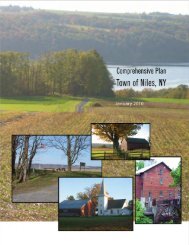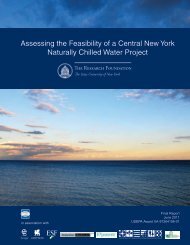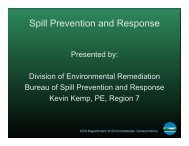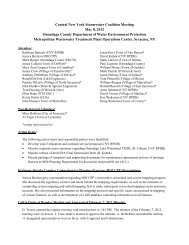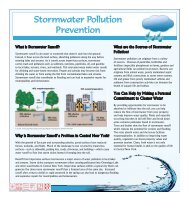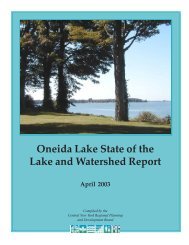A Management Strategy for Oneida Lake and its ... - CNY RPDB Home
A Management Strategy for Oneida Lake and its ... - CNY RPDB Home
A Management Strategy for Oneida Lake and its ... - CNY RPDB Home
You also want an ePaper? Increase the reach of your titles
YUMPU automatically turns print PDFs into web optimized ePapers that Google loves.
Managing Double-Crested Cormorants<br />
Program Goal<br />
Manage the <strong>Oneida</strong> <strong>Lake</strong> cormorant population in order to alleviate <strong>and</strong> prevent conflicts with<br />
other public resources including other colonial-nesting waterbird species <strong>and</strong><br />
economically important recreational fisheries<br />
In 2003 the <strong>Oneida</strong> <strong>Lake</strong> Watershed Advisory Council identified double-crested cormorants as<br />
one of eight primary issues of concern in the <strong>Oneida</strong> <strong>Lake</strong> watershed. In response to this issue,<br />
the Watershed Advisory Council Board of Directors <strong>for</strong>mally voted to endorse the recommendations<br />
of the NYS Department of Environmental Conservation Cormorant Task Force <strong>and</strong> the<br />
actions identified in the publication titled, “<strong>Management</strong> of Double-Crested Cormorants to<br />
Protect Public Resources in New York – Statement of Findings” (revised May 14, 2004). A<br />
summary of the findings is found below.<br />
Problem Identification<br />
The double-crested cormorant, Phalacrocorax<br />
auritus, is a large, fish-eating waterbird native<br />
to North America that has been federally<br />
protected since 1972 by amendments to the<br />
Migratory Bird Treaty Act. Cormorants are<br />
colonial birds that nest in high densities in<br />
areas with abundant fish. These areas are often<br />
the same habitats used by other colonialnesting<br />
bird species.<br />
Double-crested cormorants were first observed<br />
in significant numbers on <strong>Oneida</strong> <strong>Lake</strong><br />
in 1984. Cormorant numbers have grown<br />
from a single breeding pair in 1984 to a<br />
maximum of 365 documented breeding pairs<br />
in <strong>Oneida</strong> <strong>Lake</strong> in 2000. Resident cormorant<br />
populations are seasonally augmented by<br />
migrating flocks in the spring <strong>and</strong> especially<br />
fall. Populations have reached historic highs<br />
due to a combination of factors including<br />
water quality improvements (including<br />
reduction in pesticide residues such as DDT<br />
which interfered with reproduction), increased<br />
food availability in breeding <strong>and</strong> wintering<br />
areas, <strong>and</strong> federal <strong>and</strong> state protection.<br />
Walleye <strong>and</strong> perch are the major components<br />
in the diet of <strong>Oneida</strong> <strong>Lake</strong> cormorants. Their<br />
diet also consists of gizzard shad, log perch,<br />
emerald shiners, pumpkinseed sunfish, burbot,<br />
white perch, rock bass, mudpuppies, smallmouth<br />
bass, white bass, white suckers, black<br />
crappie, <strong>and</strong> tessellated darters.<br />
Impacts<br />
In 2001, cormorants on <strong>Oneida</strong> <strong>Lake</strong> consumed<br />
an estimated 2.8 million fish of which<br />
2 million were subadult yellow perch <strong>and</strong><br />
350,000 were subadult walleye. 5 Loss of<br />
highly valued recreational fish species including<br />
walleye <strong>and</strong> yellow perch negatively<br />
impact the economy of the <strong>Oneida</strong> <strong>Lake</strong><br />
region.<br />
Other impacts of high cormorant populations<br />
include their denuding of vegetation on<br />
isl<strong>and</strong>s <strong>and</strong> their competition <strong>for</strong> food <strong>and</strong><br />
habitat with other colonial nesting birds.<br />
Cormorants threaten the existence of other<br />
colonial-nesting waterbirds by physically<br />
5 VanDeValk, A.J., C.M. Adams, L.G. Rudstam, J.L. Forney,<br />
T.E. Brooking, M.A. Gerken, B.P. Young, <strong>and</strong> J.T. Hooper.<br />
2002. Comparison of angler <strong>and</strong> cormorant harvest of walleye<br />
<strong>and</strong> yellow perch in <strong>Oneida</strong> <strong>Lake</strong>, NY. Tran. Am. Fish. Soc.<br />
131: 27-39.<br />
page 70<br />
Chapter 3: Priority Areas



